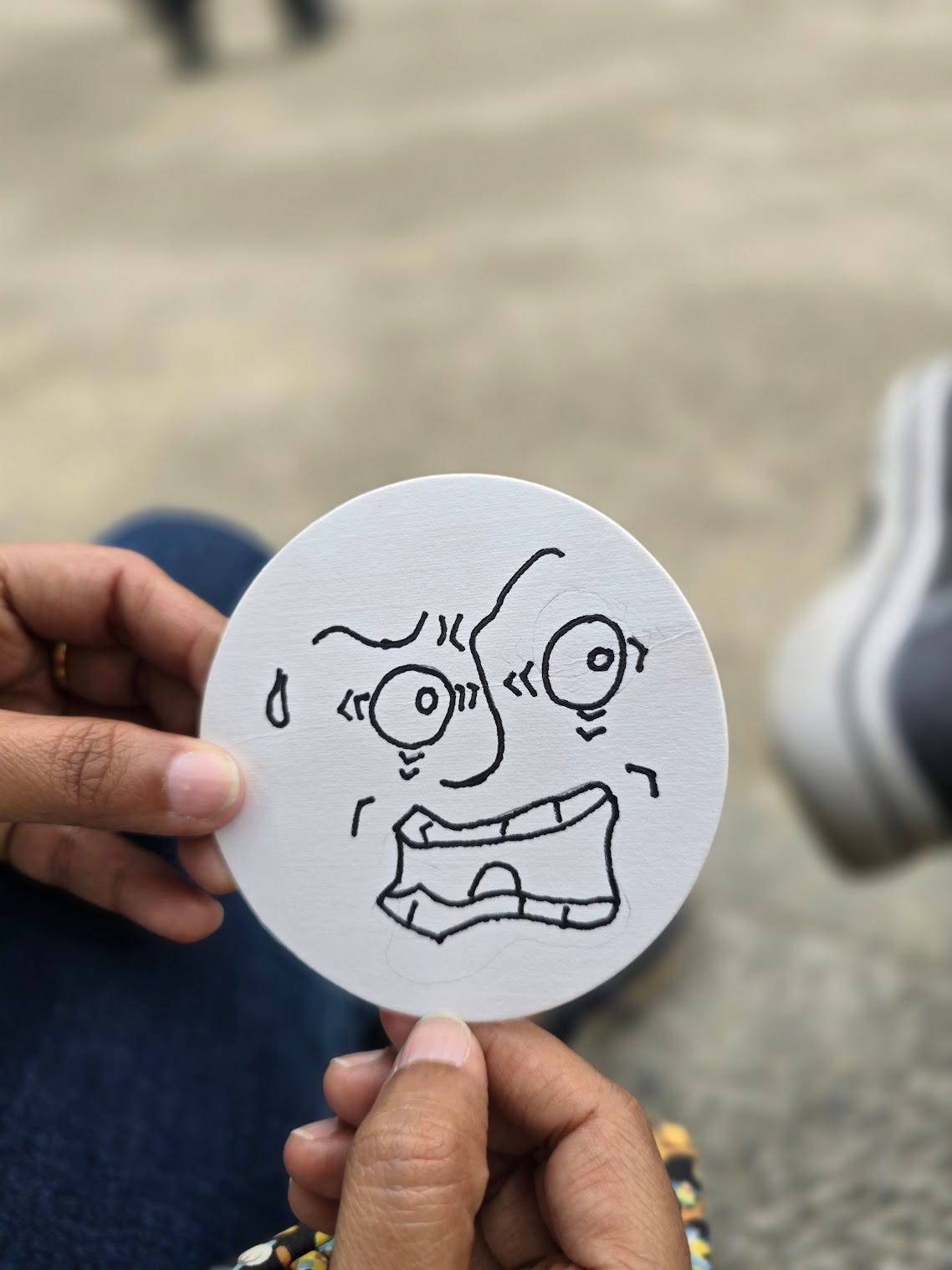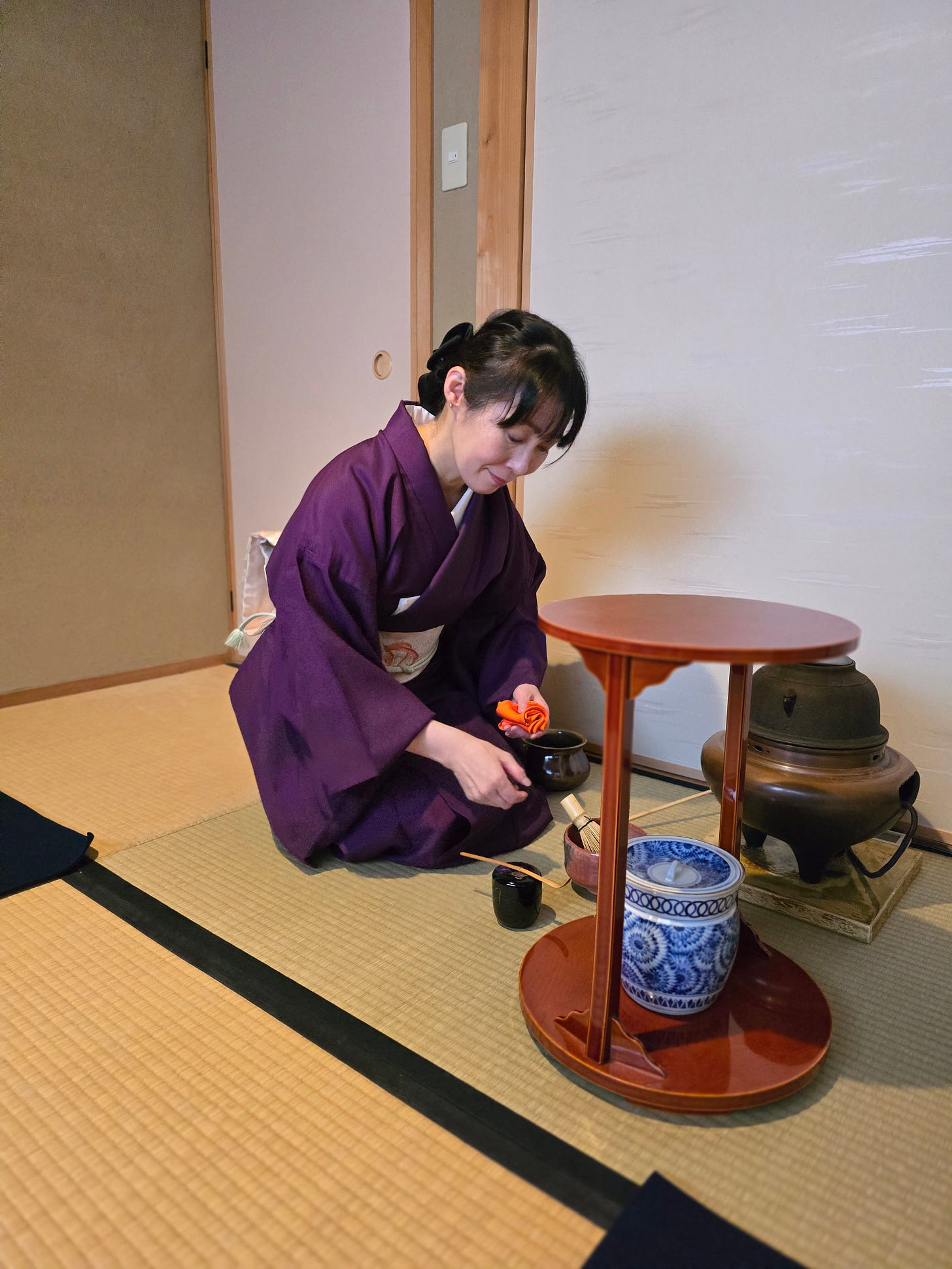Japan Trip Part 2: Mindfulness, Precision and Smallness
Tea ceremony, Kawaii, 800 year old Bonsais and a clumsy man in tiny spaces
This is part 2 of my notes from trip to Japan. You can read Part 1 here. Things I am never going to improve on in life: a) Stop being addicted to coffee b) Make my travel writing concise.
We attended a tea ceremony in Kyoto. As part of the private ceremony1, we sat in a traditional Japanese tea room as the host explained the origins of matcha, the tea ceremony process, and its role in Japan. Then she made us tea, and it struck me how precise everything was. The idea of an elaborate ritual to have tea means you begin to appreciate every movement or action.
When you walk into a sparse Japanese tea room with square tatami mats and brown palettes all around, the assortment of tea-making items laid out on the side, you feel an aura of formality. It’s a kind of restrained relaxation. Without realizing it, my movements became slower and more deliberate. I sat on the tatami mat as if I was going to be anointed.
Sure, it’s just tea, but it highlights the importance of two things:
The environment and the setup create outcomes. Sociological studies have contended that if you try to make a public place pretty, people maintain it better (Pygmalion effect, Broken Windows Theory, etc.).
Rituals are physical hacks for changing your mind-space - the reason elite sportsmen and performers always have it.
Back to the tea ceremony. The Teishu (tea host), dressed in a pretty purple Kimono, walked in tiny steps and knelt before us, ready to make tea.
Here’s a quick rundown of the items in the room that are part of a typical Japanese tea ceremony.

One thing at a time
The fidgety monkey inside me stood still as I watched her, every step precise, every moment calibrated. She placed the bowl carefully, took two precise scoops of matcha powder, dropped them in the bowl, scooped hot water using the Hishaku from the Kama kettle and poured into the bowl. It wasn’t just a step; it had the gravity of a woman balancing on a rope - a delicate precision and focus.
“In Zen, you focus on only one thing at a time,” she said.
The Zen term for it is ichigyo-zammai, which means focusing intensely on one action.
Sunryu Suzuki, the Zen monk who made Zen Buddhism famous the world over:
So instead of having some object of worship, we just concentrate on the activity which we do in each moment. When you bow, you should just bow; when you sit, you should just sit; when you eat, you should just eat. Every step, every action, has a purpose and needs attention.
I had a brief vision of how I eat dinner most days: A plate of food in my hand, plopped on the couch, a TV running in front of me as I eat while casually scrolling through my Phone. I was probably diluting all three experiences.
Our Teishu poured hot water into the bowl with Matcha and whisked it briskly before presenting it to us - frothy, silky and very delicious. Matcha is a flavour I have grown to love over time.
A rundown on whisking technique (likely incomplete):
You go front and back (duh).
You don’t hit the bottom of the tea bowl (you don’t want to damage the Chasen).
Use your wrist only.
You do it vigorously until the matcha fully froths over.
When it’s done, you whisk in slow circles and lift from the edge of the teacup.
I mean, it’s whisking. But when she did it, it was art; when I did it, I looked like a spasming monkey splashing on a puddle.
The presentation of the teacup had ceremony, too—she turned it around precisely 180 degrees and presented the artful face of the cup (with the designs) to us. The teacup was a piece of art to be fully observed, deliberated on, and enjoyed as you sipped your tea.
This tea ceremony felt like a perfect moment of mindfulness, a reminder that extreme mindfulness reveals more of the fractal I talked about in the previous post—it unfurls the universe within the universe, and suddenly, what you thought was just a momentary blip can last for a length of time that feels significant.
Bonsais
In Daitaku-ji temple, we saw a Bonsai garden filled with little trees. Bonsai Japanese pines, maples, cedars, and more grew in petite pots that fit in your living room. Their trunks were gnarly and wise, full of old wisdom, covered in the twisty scars of time and pretty moss, which lent the whole Bonsai a slightly fantasy-filled feel. Each little Bonsai was its universe, where little gnomes lived across its levels.
Then we looked at the age.
Nearly a dozen were 100 years old, half a dozen were 250 years old, and one Bonsai, a little Pine Bonsai in a pot, was 800 years old.
800 years of existence, in that little form and pot!2
Imagine the patience and the wisdom.
The first 400 years of this little tree’s life were spent in warring feudal Japan under the control of the Shogun. It lived under 200 years of the Edo period, enjoying relative peace under the imperial rule after the Meiji restoration. It saw a rapidly modernizing Japan get less insular to the outside world until it wore the hat of an imperialist to terrorize its Asian neighbours. It saw the world wars, the atomic bombs and the rise of modern Japan as a technological and cultural tour de force.
Imagine all the kings, shoguns, emissaries, poets, master gardeners it had seen. Right now, it witnessed two very average Indians standing before it.
That little thing blew my mind big.
Kawaii and smallness
One of the best ways to immediately befriend the Japanese is to call something they own (a bag, a pet, their clothes) ‘Kawaii’. Like many Japanese expressions, we can only project its meaning in the English linguistic space, and it translates to cute, loveable, charming, etc., depending on the context. But really, it's a feeling. When you see Hello Kitty images, cute anime characters, and the wild mascots that dot everything in Japan, it’s all manifestations of Kawaii.
One of its defining characteristics is the attribute of smallness. The small is a big deal in Japan.
The Bonsais perfectly manifest this. So does N.
When walking the gardens of Osaka Castle, three Japanese grandmothers kept smiling at us as they walked towards us. As we crossed, one of them beamed at N and said, “Kawaii.” Another lady, assuming we didn’t understand, immediately translated it for us: “charming.” We all giggled like kids and continued on. N is small. And N is very Kawaii. I wholeheartedly agree with those grammas.
We were eating in one of those tiny four-seat restaurants when a Japanese lady walked in carrying a cute poodle with beady eyes that seemed to stare into my soul. Before I could stop myself, my mouth was saying, “Kawaii.” She beamed with so much happiness that despite being unable to talk or understand, she kept smiling and thanking us as we walked out of the shop together.

Smallness in Japan is pervasive and goes hand in hand with understatedness.
Nearly every restaurant we went in search of would hide in plain sight, with little to no board announcing its existence, its doorway hidden, and the place nothing but a literal hole in the wall. Nearly all places had understated designs, sober colour palettes and simple symmetry of setup. That’s when you start seeing the little things, like how lines meet perfectly, how things are arranged in relation to each other and the perfect coherence of what little colours exist.
Smallness has a certain perfection of occupying exactly the space needed.
Clumsy man in small spaces
Growing up, I’d spill my coffee/drink every third day. I can blame my daydreaming all I want, but the truth is that I am a slightly clumsy man. My clumsiness is hard to pin down because I am not always clumsy - like when I’m driving, for instance. My balance is usually pretty good, and even when I stumble, I rarely fall (de jinx de jinx!)
However, things occasionally get gnarly with small spaces, delicate objects, food, and liquids. I’ve broken objects on shop shelves and delicate furniture at home and once toppled a shelf containing jars of liquids in a relative’s kitchen.
Also, the more I think about not being clumsy somewhere, the more clumsy I become. This is similar to a weird fear of laughing in a sober public space (like a funeral). This voice in my head tells me, “You’re not supposed to laugh, but be careful.” However, something akin to the call of the void happens, and I feel a laugh coming on. It has nothing to do with how sad I am.
Japan was quite a test at times.
Every shop and restaurant in Japan was small. I’ve never squeezed through as many tiny spaces as during my Japan trips, mostly successfully. I’ve had to sit on tiny chairs in tiny bars between people. I’ve had to use all my dexterity and rein in my clumsiness to eat in the tiny space allotted without spilling, dropping or elbowing the person next to me.
In one restaurant, I had to do shape-rotator math to see how I’d get into their bathroom between the space needed to open the door, where I’d step in and how I’d close it. When I walked in shops, I’d have my hands crossed defensively because the aisles were narrow, and the objects on the shelves might be fragile. My fidgety nature had to take a back seat because, in tiny Ramen booths, my fidgeting legs might slap against the patron sitting next to me.
Japan demanded stillness and precision. There is mindfulness involved in operating in a small space or doing something small (think designing hand nail art); you have to have an extreme level of mindfulness because the margin for error may be non-existent.
Coming up in Part 3
The character cast and little moments of fun interactions from the trip— a drunk speakeasy bar cocktail maker, a lone woman who runs a 5-floor restaurant, a Punjabi UK family meeting in front of a gyoza shop queue, being accosted by Japanese school kids in Osaka castle and more.
Extreme optimization under severe constraints - how everything in Japan is aesthetically maximized under clear and unchangeable constraints (a story of Nintendo, bento boxes, small restaurants, zen gardens, bonsai, and animation sequences in Ultraman).
My completely unsubstantiated hypothesis of the deer in Nara being cute af but a little racist.
Dotonbori as a jarring tourist hell and how Osaka had to win us over later.
Could be Worse,
Tyag
Camellia Tea Ceremony has two locations: One is right in the heart of Ninenzaka, and the other is in stunning gardens near Ryoan-ji temple. We went to the Ninenzaka one.









That looks like a shaving brush - the thing used to whisk your matcha
This is a lovely write up. I haven't yet read the first part of the series and I shall do so forth with. Looking forward to the third part.
I have long been curious about how an ADHD person would experience growing up in Japan. Would he have a hard time because of the extreme attention to detail that the culture requires? Or would the experience of mindfulness practice that is built into everyday life train his mind and alleviate his symptoms? Or perhaps the minimalism of the environment makes it less of a sensory overload for him and makes life easier?